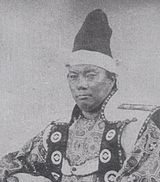- Matsumae clan
-
This article is about the Japanese clan. There is a town with this name in Hokkaidō, see Matsumae, Hokkaidō.
Matsumae Family name 
This is the mon of the Matsumae clan.The Matsumae clan (松前氏 Matsumae-shi) was a Japanese clan which was granted the area around Matsumae, Hokkaidō as a march fief in 1590 by Toyotomi Hideyoshi, and charged with defending it, and by extension all of Japan, from the Ainu 'barbarians' to the north. The clan was originally known as the Kakizaki clan who settled Kakizaki, Kawauchi, Mutsu of the Shimokita Peninsula. Claiming descendence from the Takeda of Wakasa province, the family later took the name Matsumae. In exchange for their service in defending the country, the Matsumae were made exempt from owing rice to the shogunate in tribute, and from the sankin kōtai system, under which most daimyo (feudal lords of Edo period Japan) were required to spend half the year at Edo, while their families were, essentially, held hostage to prevent rebellion, spending the entire year at Edo.
Due to their location, and their role as border defenders, the Matsumae were the first Japanese to negotiate with Russia in any semi-official way. They might very well have been the first Japanese to meet Russians at all, within Japanese territory. In 1778, a merchant from Yakutsk by the name of Pavel Lebedev-Lastoschkin arrived in Hokkaidō with a small expedition. He offered gifts, and politely asked to trade. The Matsumae official tried to explain that he had no authority to agree to trade on behalf of the shogun and that they should come back the following year. The following September, the Russians did just that, according to some accounts misinterpreting what had been said, and expecting to trade. Their gifts were returned to them, they were forbidden to return to the island, and were advised that foreign trade was only allowed at Nagasaki, a port on the southern-most of Japan's home islands. In 1790, a massive earthquake struck Hokkaidō, and a forty-two-foot tsunami lifted the Russian ship[clarification needed] out of the sea, depositing it a quarter-mile inland.[citation needed] The merchant Lebedev thus gave up on Hokkaidō.
The Matsumae clan's fief had extensive contacts with the Ainu of Hokaido, and had exclusive rights to trade with the Ainu communities of the island's and to guarantee the security of Japanese interests in the area. The Matsumae relations with the Ainu was conflictive at times, demonstrating that their power was not absolute in the region. In 1669 what started as a fight for resources between rivaling Ainu clans developed into a rebellion against the Matsumae control of the region until 1672 when Shakushain's Revolt was finally put down. The last serious Ainu rebellion was the Menashi-Kunashir Rebellion in 1789. Kakizaki Hakyō painted the Ishū Retsuzō, a series of portraits of Ainu chiefs, in order to prove to the Japanese populace that the Matsumae were capable of controlling the northern borders and the Ainu[citation needed]. The 12 paintings of Ainu chiefs were displayed in 1791 in Kyoto.
At roughly the same time, in 1789, Finnish professor Erik Laxman, of the Russian Academy of Sciences, came across several Japanese castaways in Irkutsk. Like several other Japanese before them, they had been found in the Aleutians, off the coast of Alaska, by Russian sailors and had asked to be brought back to Japan. Like those before them, these castaways had been transported instead across Siberia on their way to St. Petersburg. Laxman saw this as an opportunity to work towards the opening of Japan, and suggested this to Catherine the Great who agreed. In 1791 she appointed the professor's son, Lt. Adam Laxman, to command the voyage to return these castaways to Japan, and to open discussions of a trade agreement.
The expedition reached Hokkaidō in October of 1792, and found the Japanese surprisingly hospitable. The Russians were allowed to spend the winter, and their forms were sent to the bakufu in Edo. However, Professor Laxman insisted on bringing the castaways to Edo, and that he would sail there himself even against the Shogun's desires. The bakufu sent an envoy to the Matsumae, requesting that the Russians make their way to the town of Matsumae by land; sensing a trap, the Russians refused, and were eventually allowed to make port in Hakodate, escorted by a Japanese vessel. They were given a guest house near Matsumae castle, and were, unusually, allowed their Western customs (they did not deny their Christianity, remove their boots indoors, nor bow to the Shogun's envoys), with little or no negative repercussions. They were given by the Japanese envoys three swords and a hundred bags of rice.
They were informed that the Shogun's rules remained unchangeable: foreigners could trade at Nagasaki only, if they came unarmed. All other ships would be subject to seizure. Due to his purposes in returning castaways, Laxman was granted a pardon in this instance, but he refused to relinquish the castaways until given something in writing answering his request for trade. The envoys returned three days later with a document, restating the rules regarding trade at Nagasaki, and the laws against the practice of Christianity in Tokugawa Japan. The Russians never did establish any regular system of trade at Nagasaki, and historians today still disagree as to whether the document given to Professor Laxman was an invitation to trade, or an evasive maneuver on the part of the shogunate. The Russian expedition led by Adam Johann von Krusenstern and Nikolai Rezanov stayed six months in the port of Nagasaki in 1804-1805, failing to establish diplomatic and trade relations with Japan.
 Cropped and enlarged segment of "Deputy of the Prince of Matsmay" (image at left). The detail of the Matsumae clan mon on the clothing of the standing figure in background looks like four diamond-shapes turned sideways.
Cropped and enlarged segment of "Deputy of the Prince of Matsmay" (image at left). The detail of the Matsumae clan mon on the clothing of the standing figure in background looks like four diamond-shapes turned sideways.
 This 1856 print is entitled "Deputy of the Prince of Matsmay." This artist's impression of four samurai was amongst the images which were published after the Perry Expedition "opened the door" to Japan.
This 1856 print is entitled "Deputy of the Prince of Matsmay." This artist's impression of four samurai was amongst the images which were published after the Perry Expedition "opened the door" to Japan.
Since the Matsumae land was a march, a frontier land used as the border defense against the Ainu, the remainder of Hokkaidō, then called Ezo, essentially became an Ainu reservation. Although Japanese influence and control over the Ainu gradually grew stronger over the centuries, at that time, they were left to their own devices and were not considered part of Japanese territory by the shogunate. It was only during the Meiji Restoration in the late 19th century that the march was dissolved and Hokkaidō formally annexed by Japan.
See also
References
- Howell, David (2005). "Geographies of Identity in Nineteenth-Century Japan." U of California Press.
- McDougall, Walter (1993). "Let the Sea Make a Noise: Four Hundred Years of Cataclysm, Conquest, War and Folly in the North Pacific." New York: Avon Books.
- First volume of "The House Record of Matsumae", in Japanese
- List of the generations of Matsumae daimyo
External links
Categories:- Japanese clans
- Matsumae clan
- People from Hokkaidō
Wikimedia Foundation. 2010.

